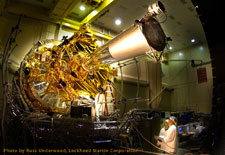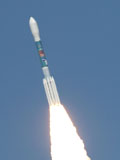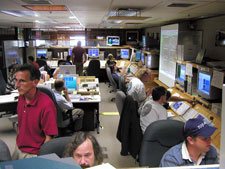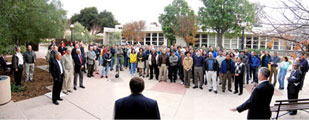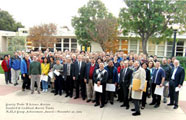The Legacy of GP-B
On this page:
A Successful Mission
Managing a flight program such as GP-B, in which the spacecraft contained only a single, highly integrated payload proved to be a challenge for NASA, its government overseers, Stanford University as NASA’s prime contractor, and Stanford’s subcontractor, Lockheed Martin—so much so that in 1984, the then NASA Administrator, James Beggs, remarked that GP-B was not only a fascinating physics experiment, but also a fascinating management experiment. NASA thoroughly addressed these challenges, and the many years of planning, inventing, designing, developing, testing, training and rehearsing paid off handsomely for GP-B, culminating in a highly successful flight mission.
Beginning with a picture-perfect launch, bull’s-eye orbit insertion, and breath-taking live video of spacecraft separation, the mission got off to a flawless start. The preparedness of the GP-B mission operations team immediately became evident in its deft handling of two major anomalies that occurred within the first month of the mission—the automatic switch-over from the main to the backup flight computer due to proton strikes induced by solar flares and two micro thrusters that had to be isolated due to stuck-open valves. In both cases, the team’s knowledge and well-coordinated responses resulted in efficient mitigation of the problems and timely restoration of nominal spacecraft operations. Furthermore, the experience of working through major anomalies early in the mission provided invaluable experience that enabled the team to handle similar anomalies during the science phase of the mission with even more efficiency.
GP-B is arguably one of the most sophisticated spacecraft ever flown. It incorporated many new technologies— most notably the gyros, their suspension systems, the accompanying SQUID readouts, and the precision-pointing of the spacecraft-fixed telescope, whose debut performance in space occurred during this mission. It is remarkable, and a testament to the preparation, talent, knowledge and skill of the Stanford-NASA-Lockheed Martin development team, that all of these technologies performed exceedingly well on orbit, with some, such as the GSS and SQUID readouts, far exceeding their required performance specifications. Likewise, the GP-B mission operations team was one of the best ever assembled. During IOC, even the most difficult and risky operations, including gyro spin-up, low-temperature bakeout of the excess helium gas, and gyro spin-axis alignment all proceeded smoothly. The one system that required considerable fine-tuning well into the science phase of the mission was the Attitude and Translation Control (ATC) system. Due in large part to solar environment sensitivity of the external Attitude Reference Platform (ARP), on which the ATC’s star trackers were mounted, parameters in the ATC system had to be seasonally adjusted in order for the spacecraft’s required precision pointing to be maintained. By April 2005, all of the issues with the ATC had been identified and addressed, and from that time forward, the ATC system performance was quite good.
By the end of IOC in August 2004, GP-B team members had a masterful command and knowledge of the spacecraft’s systems and its nuances, and they were well-primed to handle any situation or anomaly that might occur during the ensuing science (data collection) and instrument calibration phases. As it turned out, the helium in the dewar lasted 17 months and 9 days—a month longer than had been anticipated through numerous helium lifetime tests performed throughout the mission by the dewar team. This made it possible to collect science data for 50 weeks, just 14 days shy of the one-year data collection goal, and this was of great benefit to the GP-B science team. In fact the helium lasted long enough for the team to perform many extra calibration tests following the science data collection phase.
During the months after the flight mission, the team performed several feasibility tests of possible post-mission experiments, and then they readied the spacecraft for a hibernation state, from which it can be awakened at any time, in the event that there is interest and funding for post-mission experiments or uses of the spacecraft. During the hibernation preparations, the GP-B team learned that the United States Air Force Academy (USAFA) might be interested in using the GP-B satellite both for training purposes in aerospace engineering courses and possibly for physics experiments as well. It took several months to make the necessary funding and logistics arrangements, but finally in early 2007, the USAFA began controlling the spacecraft from its own mission operations center in Colorado Springs, CO. (The non-cryogenic systems aboard the GP-B spacecraft will remain functional in orbit for another ten years or more.) You can read more about the USAFA's use of the GP-B spacecraft in the September 2007 Status Update.
Extraordinary Accomplishments
Following is a list of some of the extraordinary accomplishments achieved by GP-B during the 17 months of its flight mission.
- Over the course of the 17.3-month mission, we communicated with the spacecraft over 4,000 times, and the Mission Planning team successfully transmitted over 106,000 commands to the spacecraft.
- GP-B is the first spacecraft ever to achieve nine degrees of freedom in control. The spacecraft itself maintained three degrees of freedom in attitude control (pitch, yaw, and roll), plus three degrees of freedom in translational drag-free control (front-to-back, side-to-side, and up-down). In addition, the Gyro Suspension System (GSS) for each gyro maintained three degrees of freedom in controlling the location of its spherical rotor within the gyro housing.
- The GP-B gyros, which performed extraordinarily well in orbit, have been listed in the Guinness Database of World Records as being the roundest objects ever manufactured.
- The spin-down rates of all four gyros were considerably better than expected. GP-B’s conservative requirement was a characteristic spin-down period (time required to slow down to ~37% of its initial speed) of 2,300 years. Measurements during IOC showed that the average characteristic spin-down period of the GP-B gyros was approximately 15,000 years—well beyond the requirement.
- The magnetic field surrounding the gyros and SQUIDs (Super-conducting QUantum Interference Device) was reduced to 10-7 gauss, less than one millionth of the Earth’s magnetic field—the lowest ever achieved in space.
- The gyro readout measurements from the SQUID magnetometers had unprecedented precision, detecting fields to 10-13 gauss, less than one trillionth of the strength of Earth’s magnetic field.
- The gyro suspension system operated magnificently. It had to be able to operate both on the ground for testing purposes prior to launch, as well as in space. This meant that the suspension system had to operate over 11 orders of magnitude—an enormous dynamic control range—and its performance throughout the mission was outstanding.
- The science telescope on board the spacecraft tracked the guide star, IM Pegasi (HR 8703), to superb accuracy, and it also collected a year’s worth of brightness data on that star. The brightness data we collected on IM Pegasi represents the most continuous data ever collected on any star in the universe.
Awards & Honors
In the past few years, a number of awards have been bestowed on the GP-B program, its science and operations team, and the principal investigator, Francis Everitt. Following is a chronological list of these awards.
- 2004 — GP-B gyroscopes listed in the Guinness Database of World Records as "the most spherical manmade objects."
- 2004 — Popular Science Magazine "Best of What's New in Aviation & Space" Award.
- 2005 — NASA Distinguished Public Service Medal awarded to GP-B Principal Investigator, Francis Everitt.
If there is one person who, along with William Fairbank has proved to be the driving force of GP-B since his arrival in 1962, it is Francis Everitt. His leadership has markedly advanced the state of the art in the areas of cryogenics, magnetics, quantum devices, telescope design, control systems, quartz fabrication techniques, metrology and, most of all, gyroscope technology. The fact that GP-B survived no fewer than seven potential cancellations, finally launched in April 2004, successfully completed a 17-month flight mission, and is now in the final stages of analyzing the relativity data is a direct tribute to Everitt’s leadership, tenacity, and dogged pursuit of the experimental truth. It was in recognition of these seminal contributions that, in April 2005, NASA awarded Everitt the Distinguished Public Service Medal—the highest award that NASA can confer upon a nongovernment employee. You can read more about this award in the GP-B Status Update of May 13, 2005. The certificate accompanying the medal reads:
"For extraordinary leadership and scientific achievement as Principal Investigator for the Gravity Probe B program."



NASA s Medals Francis Everitt receiving NASA Distinguished Public Service medal Certificate accompanying the medal -
2005 — NASA Group Achievement Award presented to all members of the GP-B Science Mission Team.
In late November 2005, approximately two months following the end of the GP-B Science and Instrument Calibration phases of the GP-B mission, Tony Lyons, the GP-B Program Manager from NASA's Marshall Space Flight Center flew to Stanford to present a NASA Group Achievement Award certificate to each and every member of the joint Stanford-Lockheed Martin Science Mission Team. You can read more about the award ceremony in the Mission Operations section and also in the GP-B Status Update of December 2, 2005. The certificate received by each team member reads as follows:
“For exceptional dedication and highly innovative scientific and engineering accomplishments leading to the successful execution and completion of the Gravity Probe B Science Mission.”
- 2006 — GP-B and HEPL received awards from the Space Technology Hall of Fame
for supporting the successful development and commercialization of GPS precision guidance technology.
On April 6, 2006, the Novariant AutoFarm RTK AutoSteer technology, along with four principal members of Novariant, were inducted into the Space Technology Hall of Fame in an awards ceremony at the 22nd National Space Symposium in Colorado Springs, CO. Novariant Inc. is a GPS Precision Guidance technology company founded by former GP-B graduate student, Clark Cohen, and some of his fellow graduate students. Furthermore, at the ceremonies, both Novariant Corporation and the Gravity Probe B program were recognized for their roles as the innovating organizations under which this technology was developed, and former Program Manager, Gaylord Green, accepted this award on behalf of GP-B. Finally, NASA's Marshall Space Fight Center and the Stanford W.W. Hansen Experimental Physics Lab (HEPL), under which GP-B is administered, received organizational commendation awards for their roles in supporting the successful development and commercialization of this technology—recognizing these institutions as outstanding examples of applying space technology for the betterment of life on Earth. Brad Parkinson accepted this award on behalf of Robert Byer, Director of HEPL, and it is fitting that Parkinson, himself, also received an individual commendation award for his role in the development of this technology. You can read the full story about this award, entitled "From Einstein to Farming" in the GP-B Status Update of March 31, 2006.

The Space Technology Hall of Fame medal awarded to the GP-B Labs in on April 6, 2006 - 2007 — Huntsville, AL Chapter of the National Space Club presented GP-B
the Astronautics Engineer
Award
On October 22, 2007 at their 19th annual Wernher von Braun Memorial Dinner, the Huntsville, AL chapter of the National Space Club presented their 6th annual Astronautics Engineering award to GP-B. Principal Investigator, Francis Everitt, attended the banquet and accepted the award on behalf of the team.


Awards booklet from National Space Club, Huntsville, AL Chapter GP-B Award trophy - 2008 — Astronomy Magazine selects GP-B as #1 of its Top Ten Space Stories of 2007
- 2010 — March 11: Francis Everitt and Sir Roger Penrose Awarded 2010 Trotter Prize and Delivered Trotter Lectures at Texas A&M University
On Thursday, March 11, 2010, two physicists—Francis Everitt from Stanford and Sir Roger Penrose from Oxford—were jointly awarded the ninth annual Trotter Prize at Texas A&M University. The annual Trotter event includes both a cash prize to the recipient(s) and an endowed public lecture series. The Trotter Prize in Information, Complexity and Inference is awarded annually for pioneering contributions to the understanding of the role of information, complexity and inference in illuminating the mechanisms and wonder of nature.
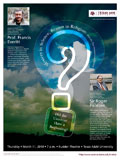
2010 Trotter Prize &Lecture Poster
(Click to enlarge)The Trotter Lecture seeks to reveal connections between science and religion, often viewed in academia as non-overlapping, if not rival, worldviews. For this year’s Trotter Lecture, both Everitt and Penrose spoke on this topic. Everitt’s talk, entitled “Mystery in Science, Reason is Religion,” explored how mystery and moral discipline permeate both science and religion and how reason affects each in the context of Christian faith. Penrose’s talk, entitled “ Did the Universe Have a Beginning?” explored the philosophical implications of conformal cyclic cosmology (CCC), which Penrose offers as an alternative scheme to the prevailing Big Bang theory.
For more information, see:
In September 2004, GP-B received a certificate from Guinness World Records Limited, acknowledging that the GP-B gyroscope rotors had been entered into the Guinness Database of World Records. The certificate reads as follows:
“The most spherical man-made objects are the fused quartz gyroscopic rotors onboard the Gravity Probe B Spacecraft operated by NASA and Stanford University. Their average departure from mathematically perfect sphericity is only 1.8 x 10-7 of their diameter.”
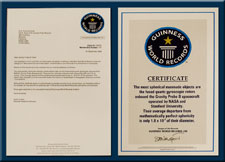 |
| Letter and certificate from the Guinness World Records Company |
Technology Transfer To Other NASA Missions
While the primary goal of the GP-B is to make the best possible measurements of the predictions of General Relativity, the mission, however, would not be possible without numerous engineering advances and the development of new technologies in the areas of cryogenics, ultra high vacuum systems, precision manufacturing, avionics design, and spacecraft control. A number of proposed NASA missions, including LISA and STEP, base their design and estimates of ultimate performance of their systems on the demonstrated performance of GP-B while on orbit. The following table summarizes technologies developed for GP-B that are now available for other NASA missions.
| Technology Category | Specific Implementation | Realization |
|---|---|---|
| Precision quartz fabrication and metrology | Roundness fab & metrology | 20nm peak to valley |
| Density homogeneity | parts in 107 | |
| Surface orientation | 1 arc sec | |
| Flatness | better than l /20 | |
Quartz stable reference |
Mechanical stability | Strain less than 1 part in 1010 |
| Robust precision bonding | OptoBond™ hydroxide catalyzed bonding | |
Large Scale Cryogenic Systems |
Superfluid flight dewar | 2441 liters, 17.3month hold time |
| Guard Tank | 90 day post-conditioning superfluid maintenance | |
| Porous plug phase separation | Flawless on-orbit operation. Also flown on IRAS and COBE after original GP-B development | |
Cryogenic Electronics |
Superconducting thin film circuit technologies: patterning, contacting, multilayer transformers | No on-orbit failures |
| DC SQUIDs | Noise PSD 2x10-5 F0 /√Hz at 13 mHz | |
| Cryo JFET photo detectors | 0.8 fA/√Hz noise current | |
Magnetics Control |
AC shielding (superconducting) | 1 part in 1012 |
| DC field reduction (Expanded superconducting shields) | < 10-11 Tesla | |
| Precision field measurement | Absolute dc fields <10-12 T | |
| Non magnetic material control, and fab techniques | < 10-10 Tesla at gyro position | |
| Comprehensive fight part testing | 100% screening for parts within magnetic shields | |
Attitude and Translation Control |
Control of all 6 spacecraft degrees of freedom | |
| Inertial sensing. Gyro (proof mass) suspension system. | Sub nm position noise. Sub 10-12 g acceleration measurement precision | |
| Attitude Sensing | Telescope pointing noise 0.48mas/orbit | |
| He proportional thrusters | Sub to milliNewton proportional controlled | |
| Attitude and roll | ~ 200 marc sec RMS, 5 marcsec at roll frequency | |
| Translation Control | Dragfree to < 10-11 g; DC to 1Hz | |
Non-contact Charge control |
Charge Measurement via GSS electronics | 0.1 PicoCoulomb resolution |
| UV fiber optic system | Control to <5 PicoCoulomb; Discharge rate adjustable via electrode bias | |
| Mechanical fiber optic switch | No failures on-orbit | |
| Ultralow vacuum technology | Low temperature bake-out techniques, 8 K cryopump | < 10-11 Torr |
GPS system |
Orbit determination | MilliNewton force residuals in 30 hr integration |
| Time transfer | < 0.1 millisec uncertainty in science signal time relative to UTC | |
| Advanced Vehicle Control Simulation | Successful on-orbit setup and control parameter optimization |
The Broader Legacy of GP-B
When the GP-B experiment was first conceived in late 1959- 1960, the United States had just created NASA, launched its first satellite, and entered the space race. Landing men on the Moon was still nine years away. At the time, this experiment seemed rather simple, but it has taken over four decades of scientific and technological advancement to create a space-borne laboratory and measurement instrument sophisticated and precise enough to carry out these minuscule measurements of relativistic effects around the Earth.
At least a dozen new technologies had to be invented and perfected in order to carry out the Gravity Probe B experiment. For example, the spherical gyroscopes have a stability that is more than a million times better than the best inertial navigation gyroscopes. The ping-pong-ball-sized gyroscope rotors in these gyroscopes had to be so perfectly spherical and homogeneous that it took more than10 years and a whole new set of manufacturing techniques to produce them. They’re now listed in the Guinness Database of Records as the world’s roundest man-made objects.
The magnetometers, called SQUIDs (Super-Conducting Quantum Interference Devices), monitor the spin axis direction of the gyroscopes and can detect—digitally—a change in spin axis alignment to an angle of approximately 1/40,000,000th of a degree. These advances were only possible through GP-B’s unique combination of cryogenics, drag-free satellite technology, as well as totally new manufacturing and measuring technologies.
Similarly, it took two years to make the flawless roof prisms in the GP-B science telescope that tracks the guide star. Some scientists have mused about how Einstein, himself once a patent clerk, would have enjoyed reviewing these extraordinary technologies. See the Unique Challenges section in the Technology tab for descriptions of a dozen key GP-B unique technological innovations.
Over its 40+ year life span, spin-offs from the Gravity Probe B program have yielded many technological, commercial, and social benefits. For example, optical-bonding and fused-quartz technologies pioneered for GP-B have subsequently been applied to commercial products, and photo-diode detector technology developed for use in the GP-B telescope has had ramifications for digital camera improvements. Another example is GP-B's porous plug for controlling helium in space. This cryogenic technology was essential to several other vital NASA missions, including IRAS (Infrared Astronomical Satellite) and COBE (COsmic Background Explorer).
One interesting GP-B spin-off story is the evolution of precision guidance control technology from testing Einstein to plowing fields. Under the supervision of GP-B Co-PI, Brad Parkinson, centimeter-accurate Global Positioning Satellite (GPS) technology, originally developed for attitude control of the GP-B spacecraft, was re-purposed for other automated guidance control applications in the early 1990’s by Clark Cohen and a group of his fellow GP-B/GPS graduate students at Stanford. After receiving his Ph.D., Cohen founded a company, now Novariant Corporation, to develop precision GPS guidance control applications, such as an automatic aircraft landing system and automated precision farming. In May 2006, Novariant’s Autofarm technology was inducted into the Space Technology Hall of Fame, and individual awards were given to Cohen and several colleagues at Novariant, along with Parkinson and Stanford’s GP-B and Hansen Experimental Physics Lab (HEPL) for their role in supporting this technology development. (See the Novariant award in the Awards section above.)
Less tangible, but perhaps most important, the Gravity Probe B program has been an extraordinary productive training ground for generations of space scientists and engineers. To date, 83 PhDs, 5 Engineers, and 15 Masters degrees have been conferred at Stanford University to students who made important contributions to the GP-B experiment, and 14 further PhDs at other universities, Harvard; MIT; Purdue; University of Alabama, Huntsville, and the University of Aberdeen, Scotland. The distribution of Stanford PhDs have been 29 in physics, 1 in mathematics, and 53 among the Aero/Astro, Electrical, and Mechanical Engineering departments. The program also extended this unique training environment to ~340 undergraduate students from 11 departments over the life of the mission, and no fewer than 55 high school students.

